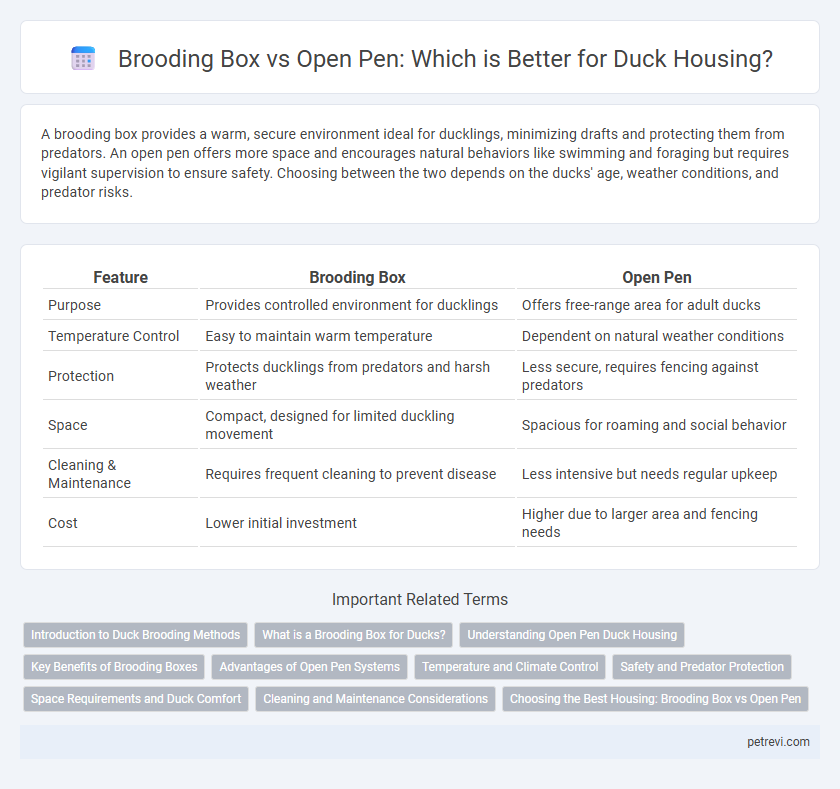A brooding box provides a warm, secure environment ideal for ducklings, minimizing drafts and protecting them from predators. An open pen offers more space and encourages natural behaviors like swimming and foraging but requires vigilant supervision to ensure safety. Choosing between the two depends on the ducks' age, weather conditions, and predator risks.
Table of Comparison
| Feature | Brooding Box | Open Pen |
|---|---|---|
| Purpose | Provides controlled environment for ducklings | Offers free-range area for adult ducks |
| Temperature Control | Easy to maintain warm temperature | Dependent on natural weather conditions |
| Protection | Protects ducklings from predators and harsh weather | Less secure, requires fencing against predators |
| Space | Compact, designed for limited duckling movement | Spacious for roaming and social behavior |
| Cleaning & Maintenance | Requires frequent cleaning to prevent disease | Less intensive but needs regular upkeep |
| Cost | Lower initial investment | Higher due to larger area and fencing needs |
Introduction to Duck Brooding Methods
Duck brooding methods involve two primary housing options: brooding boxes and open pens. Brooding boxes provide a warm, controlled environment ideal for young ducklings, ensuring protection from predators and temperature fluctuations. Open pens allow for more space and natural behavior but require vigilant management to maintain safety and appropriate warmth during early development stages.
What is a Brooding Box for Ducks?
A brooding box for ducks is a specially designed enclosure that provides a warm, safe, and controlled environment for ducklings during their crucial early life stages. It typically features insulated walls, a heat source such as a heat lamp or heating plate, and bedding to maintain comfort and prevent chilling. This setup encourages healthy growth and reduces stress compared to open pen housing, which exposes ducklings to variable temperatures and increased risk of predators.
Understanding Open Pen Duck Housing
Open pen duck housing offers superior ventilation and ample space, promoting healthier growth and reducing disease risk compared to brooding boxes. Ducks in open pens benefit from natural sunlight and easy access to water sources, enhancing their overall well-being and behavioral expression. This system supports sustainable duck farming by accommodating social interaction and minimizing stress-related issues common in confined brooding boxes.
Key Benefits of Brooding Boxes
Brooding boxes provide a controlled environment that maintains optimal warmth and humidity essential for ducklings' early development, reducing the risk of hypothermia. They offer protection from predators and weather elements, ensuring higher survival rates during the vulnerable brooding phase. The confined space also facilitates easier monitoring and management of the ducklings, enhancing health and growth outcomes.
Advantages of Open Pen Systems
Open pen systems for duck housing allow better ventilation and natural sunlight exposure, promoting healthier growth and reducing respiratory diseases. These systems provide ample space for ducks to exhibit natural behaviors such as foraging and swimming, enhancing overall welfare and reducing stress levels. Open pens also facilitate easier waste management and lower ammonia buildup compared to brooding boxes, improving sanitary conditions and bird comfort.
Temperature and Climate Control
A brooding box provides precise temperature regulation essential for ducklings' early development, maintaining consistent warmth through controlled heat sources. In contrast, an open pen relies heavily on ambient climate conditions, which can lead to temperature fluctuations impacting duck comfort and growth. Effective climate control in a brooding box reduces stress and disease risk by creating a stable microenvironment suited for vulnerable young ducks.
Safety and Predator Protection
A brooding box offers enhanced safety and predator protection for ducklings by providing an enclosed, secure environment that limits access by predators like raccoons and foxes. Open pens, while allowing more ventilation and natural light, often expose ducks to risks from aerial predators and other wildlife due to their less restrictive design. Properly constructed brooding boxes with solid walls and secure lids significantly reduce the chances of predator attacks during vulnerable early stages.
Space Requirements and Duck Comfort
Brooding boxes provide confined, warm, and secure space ideal for ducklings, usually occupying about 2-3 square feet per duckling to ensure comfort and prevent stress. Open pens require significantly more space, typically 10-15 square feet per adult duck, allowing freedom of movement, natural behaviors, and access to water features for optimal well-being. Adequate ventilation and dry bedding in both housing types are critical to maintain health and enhance duck comfort.
Cleaning and Maintenance Considerations
A brooding box offers easier cleaning and maintenance due to its compact size and contained environment, reducing debris accumulation and making waste removal more efficient. Open pens require frequent cleaning of larger areas and managing natural elements like mud and foliage, which can complicate sanitation efforts. Choosing a brooding box can help maintain a more controlled and hygienic space for ducklings, minimizing disease risks associated with poor hygiene.
Choosing the Best Housing: Brooding Box vs Open Pen
Choosing the best housing for ducks depends on their age and safety needs; brooding boxes provide a controlled, warm environment ideal for ducklings, promoting healthy growth and protection from predators. Open pens offer ample space for mature ducks to forage and exercise but require secure fencing and shelter to prevent exposure to weather and threats. Prioritize brooding boxes for early development stages and transition to open pens as ducks grow to balance comfort and natural behaviors.
Brooding Box vs Open Pen for Duck Housing Infographic

 petrevi.com
petrevi.com